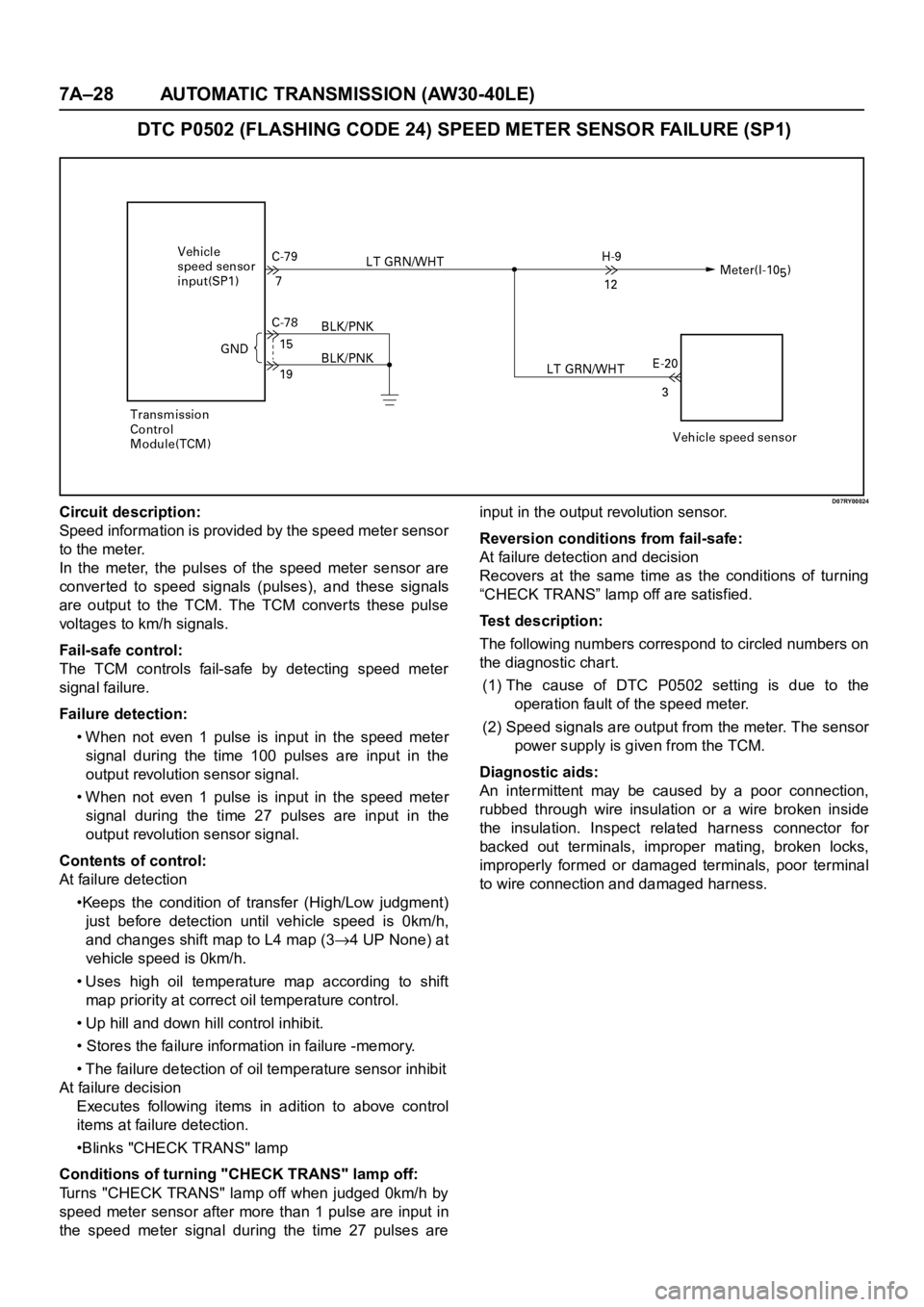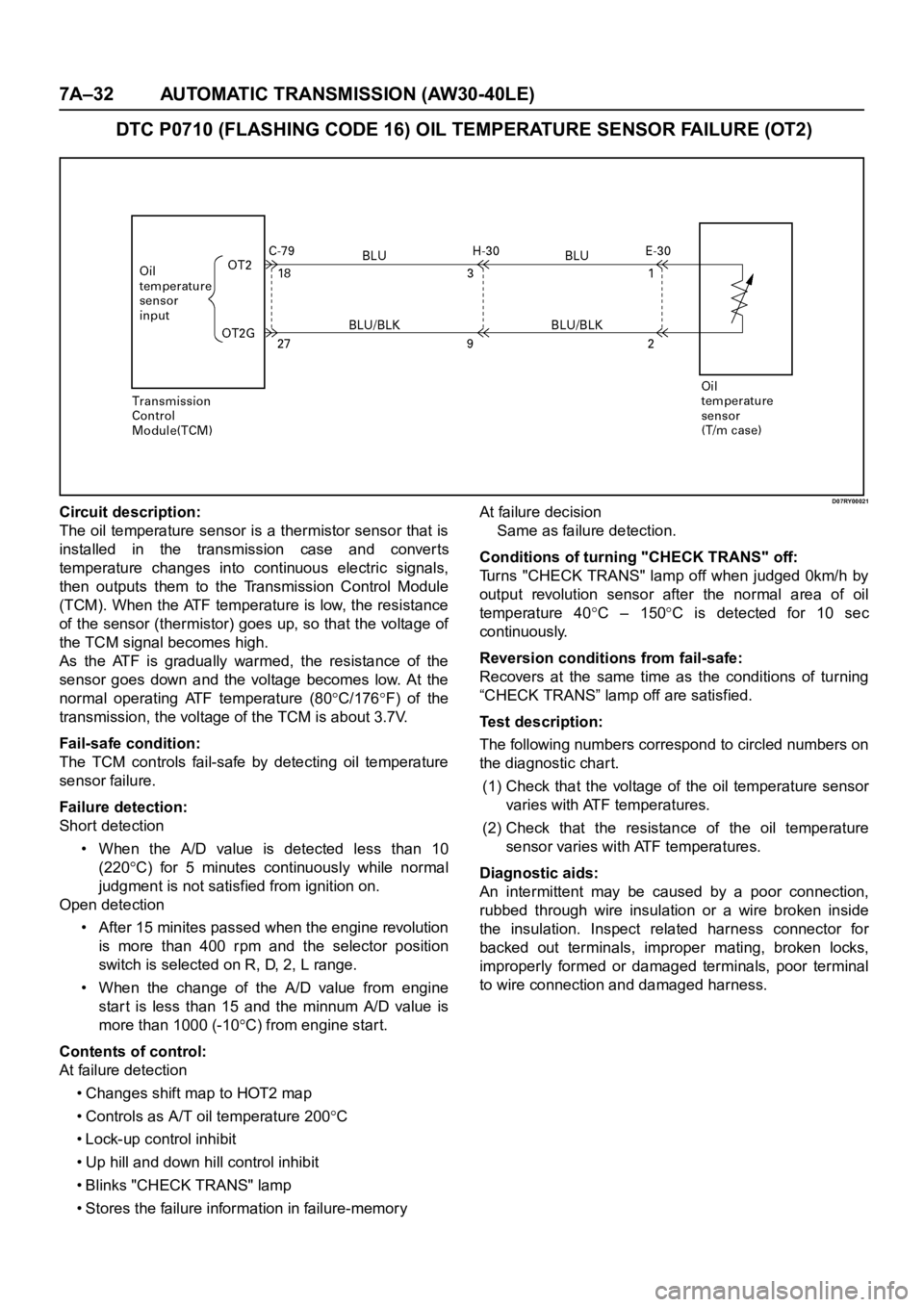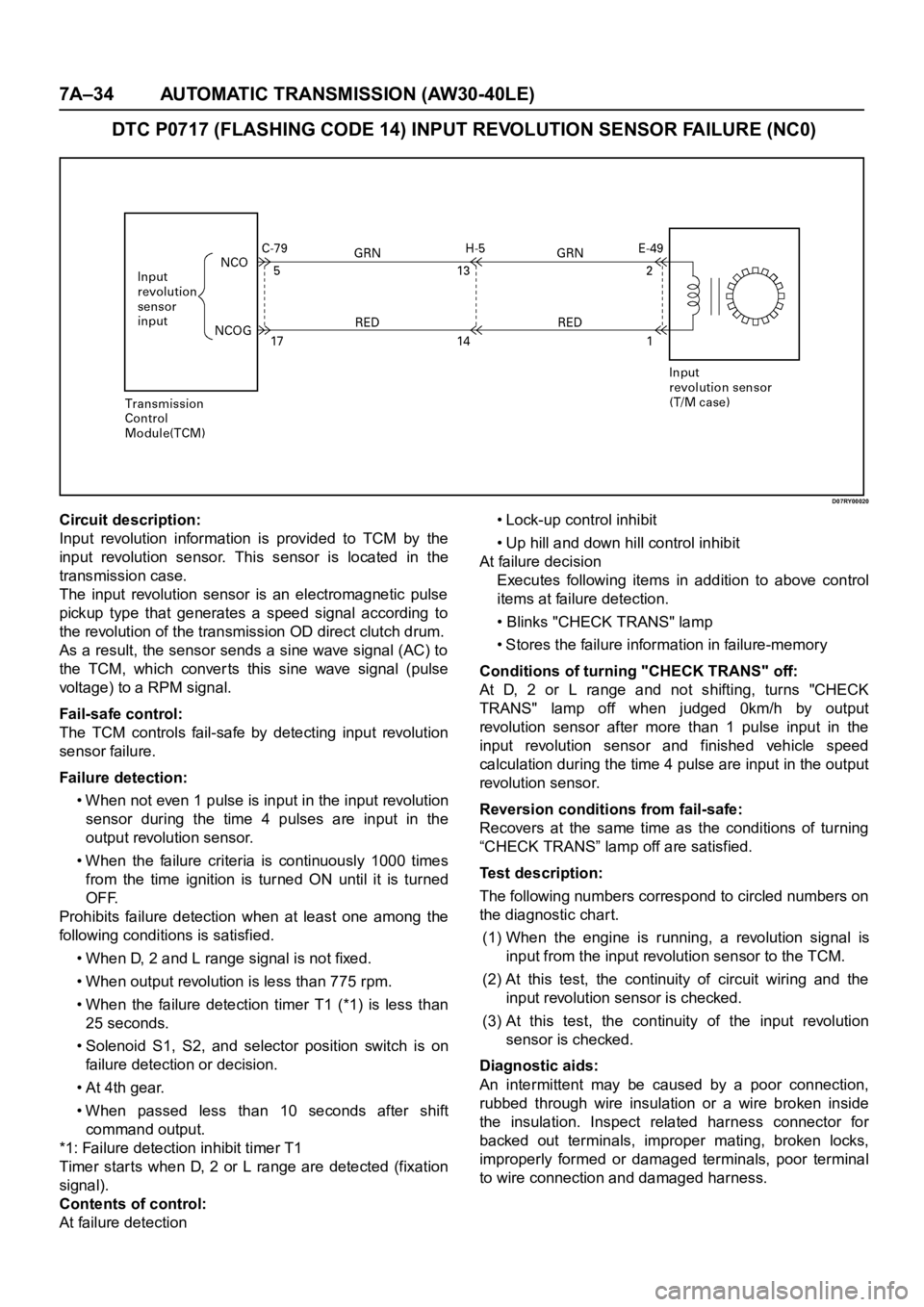1998 OPEL FRONTERA turn signal
[x] Cancel search: turn signalPage 5675 of 6000

6H – 2 ENGINE SPEED CONTROL
GENERAL DESCRIPTION
3For A/T
1For M/T
2
1
101RW012
Engine control has been changed from the control
cable system to an electronically controlled TP (Throttle
Position) sensor.
The TP sensor is a potentiometer (Variable resistance)
type and installed to the accelerator pedal bracket.
A voltage of 5 V is always applied from the ECM
(Electronic Control Module) to the TP sensor so that the
operating angle of the accelerator pedal can be
detected from a change in voltage.
Further, this sensor is equipped with an accelerator
switch which sends signals to the ECM when the
accelerator pedal is stepped on.
This switch remains on and turns off only when the
accelerator pedal is stepped on.An A/T (Automatic Transmission) vehicle is equipped
with a throttle cable for A/T use. There is a return spring
provided on the throttle cable lever side. No change in
the throttle cable lever. An MT (Manual Transmission)
vehicle has no throttle cable, and therefore, a return
spring is provided on the accelerator pedal and a return
cable assembly having the sliding resistance of a cable
is used to give the pedal a feeling.
To meet the newly adopted electronic control system,
the idling control button has been dropped. Legend
(1) Accerator Position Sensor
(2) Return Cable
(3) A/T Throttle Cable
Page 5788 of 6000

AUTOMATIC TRANSMISSION (AW30-40LE) 7A–7
CONTROL AND FUNCTIONS
Item Description
Shift and lock-up control • In D range, speed change point and Lock-up point can be changed by
setting pattern selection switch to "POWER", "NORMAL" or "WINTER"
mode.
• Gear shift position in the conditions made up of transmission shift positions
(D.2.L) combined with pattern selection switch (POWER, NORMAL, and
WINTER) can be controlled in accordance with vehicle speed and the
opening of throttle valve.
Overdrive cut control • If O/D OFF switch is set on in D range (O/D OFF lamp ON), gear shift to O/
D is not effected.
• Overdrive is released at O/D OFF switch on and high transmission oil
temperature (More than 130
C).
However, to prevent engine over revolution
•4
3 shifting at vehicle speed is less than 118 km/h.
•3
4 shifting at vehicle speed is more than 131 km/h.
Lock-up cut control • In D range, 3rd or O/D lock-up is conducted in "POWER" or "NORMAL"
mode.
• In 2, L range, lock-up is off in the whole area.
• Lock-up timing is controlled to reduce gear shift shock using kind of gear
shift (shift up, etc.) lock-up status at the time of gear shift judgement, gear
step and throttle opening after gear shift.
• Lock-up is released at brake on or high transmission oil temperature (More
than 130
C).
• Lock-up is prohibited when idling is defected by throttle position sensor.
Driving mode select control • The TCM selects a suitable driving mode from the nine kinds for the variety
driving condition.
i) Economy mode ii) Power mode iii) Winter mode iv) HOT1 mode v) HOT2
mode vi) L4 mode vii) Slope mode (Up slope 1, Up slope 2 and Down
slope mode)
• The priority of driving mode:
Economy < Power < Slope < L4 < Winter < HOT1 < HOT2
Squat control • When the TCM detects D signal on, the TCM controls 1–3–1 shift by
setting a timer, in order to improve the shift feel at N
D.
Line pressure control • The TCM output current which corresponds to throttle oil pressure to
pressure control solenoid based on throttle opening.
Indicate oil temperature warning
function• If the transmission oil temperature sensor senses that transmission oil
temperature is greater than 146
C, the TCM turn on A/T OIL TEMP
warning lamp. (The warning lamp is turned off, if oil temperature is less
than 126
C.)
L4 mode control • The TCM judges whether the transfer is engaged in high or low based on
the ratio rpm data from output speed sensor in the transmission and the
rpm data from speed meter sensor to select the shift map.
Up and down hill control • The TCM judges up and down hill, and change shift pattern based on
throttle opening and acceleration.
Correct oil temperature control • If the temperature exceeds a predetermined value, the TCM selects the
high oil temperature shift point for downshifting, thus preventing the oil
temperature from rising. (More than 130
C, D range)
Page 5790 of 6000

AUTOMATIC TRANSMISSION (AW30-40LE) 7A–9
MAJOR INPUT/OUTPUT COMPONENTS
Component Function
Input
Vehicle speed sensor (Speedometer) Detects the vehicle speed (Back-up sensor of output
revolution sensor).
Output revolution sensor (Transmission) Detects the vehicle speed.
Input revolution sensor (Transmission) Detects the input revolution (O/D direct clutch drum
revolution).
Engine revolution sensor Detects the engine revolution.
Throttle position sensor Detects the throttle opening rate.
Neutral start switch Detects the select lever position.
Pattern select switch Detects whether the driver has selected "NORMAL",
"POWER", or "WINTER" mode.
Overdrive off switch Detects whether the driver has selected O/D.
Brake lamp switch Detects whether the driver has pressed the brake pedal or
not.
Oil temperature sensor Detects the oil temperature.
Diagnostic star t switch Star ts self-diagnosis and displays a code for faulty part if
any.
Input/Output
Data link connector When connected with Tech2 or tester, can communicate
the data for function check, etc.
Output
Shift solenoid S1, S2 Selects shift point and gear position suited to the vehicle
running condition on the basis of TCM output.
Lock-up control solenoid SL Control the lock-up clutch suited to the vehicle running
condition on the basis of TCM output.
Pressure control solenoid STH Adjusts throttle pressure by energizing current of linear
pressure control solenoid to prevent the shift shock and to
obtain shift smoothly.
"CHECK TRANS" lamp When trouble has occurred to throttle position sensor,
vehicle speed sensor, or solenoid, "CHECK TRANS" lamp
is blinked to warn the driver. If also displays the trouble
code.
A/T OIL TEMP warning lamp Lights when ATF oil temperature rises. (Turned on at
greater than 146
C . Turned off at less than 126C.
Power mode lamp Informs the driver whether the vehicle is in power mode or
not.
Winter mode lamp Informs the driver whether the vehicle is in winter mode or
not.
Computer
Transmission Control Module (TCM) Based on the signal from each switch and sensors, judges
necessary shift point and lock-up operation, and send
signal to each solenoid.
Page 5807 of 6000

7A–26 AUTOMATIC TRANSMISSION (AW30-40LE)
DTC P0120 (FLASHING CODE 21) ANALOG THROTTLE SIGNAL FAILURE (VTH)
D07RY00023Circuit description:
When the signal of the engine throttle position sensor
located on the accelerator pedal is supplied to the TCM,
the TCM judges the opening condition of the throttle.
The shift point of the transmission is determined by this
opening condition of the throttle.
Fail-safe control:
The TCM controls fail-safe by detecting analog throttle
signal (VTH) failure.
Failure detection:
•When the throttle input voltage is detected less than
0.112V or more than 4.417V for 2.0 seconds.
Contents of control:
At failure detection
•Throttle opening for line pressure control ... Throttle
opening 100%
•Throttle opening for shift control ... Throttle opening
0%
•Lock-up control inhibit
•Up hill and down hill control inhibit
•Squat control inhibit
At failure decision
Executes following items in addition to above control
items at failure detection.
•Blinks "CHECK TRANS" lamp
•Stores the failure information in failure-memory
Conditions of turning "CHECK TRANS" lamp off:
Turns “CHECK TRANS” lamp off when judged 0km/h by
output revolution sensor after throttle signal input voltage
is detected more than 0.112V and less than 4.717V.
(however, uses 0 km/h judgment by back-up vehicle
speed at output revolution failure)Reversion conditions from fail-safe:
At failure detection
Immediately recovers when the throttle input voltage
is detected more than 0.112V and less than 4.717V.
At failure decision
Recovers at the same time as the conditions of
turning “CHECK TRANS” lamp off are satisfied.
Test description:
The following numbers correspond to circled numbers on
the diagnostic char t.
(1) Check that the throttle input voltage is 0.25 to 0.45V.
(2)At this test, check that as the throttle opens, the
voltage goes up and that the voltage reaches 3.74 to
4.56V at the full open status.
(3) Check the power supply voltage (4.75 – 5.25V) of the
throttle position sensor.
Diagnostic aids:
An intermittent may be caused by a poor connection,
rubbed through wire insulation or a wire broken inside
the insulation. Inspect related harness connector for
backed out terminals, improper mating, broken locks,
improperly formed or damaged terminals, poor terminal
to wire connection and damaged harness.
Page 5809 of 6000

7A–28 AUTOMATIC TRANSMISSION (AW30-40LE)
DTC P0502 (FLASHING CODE 24) SPEED METER SENSOR FAILURE (SP1)
D07RY00024Circuit description:
Speed information is provided by the speed meter sensor
to the meter.
In the meter, the pulses of the speed meter sensor are
converted to speed signals (pulses), and these signals
are output to the TCM. The TCM converts these pulse
voltages to km/h signals.
Fail-safe control:
The TCM controls fail-safe by detecting speed meter
signal failure.
Failure detection:
• When not even 1 pulse is input in the speed meter
signal during the time 100 pulses are input in the
output revolution sensor signal.
• When not even 1 pulse is input in the speed meter
signal during the time 27 pulses are input in the
output revolution sensor signal.
Contents of control:
At failure detection
•Keeps the condition of transfer (High/Low judgment)
just before detection until vehicle speed is 0km/h,
and changes shift map to L4 map (3
4 UP None) at
vehicle speed is 0km/h.
•Uses high oil temperature map according to shift
map priority at correct oil temperature control.
• Up hill and down hill control inhibit.
• Stores the failure information in failure -memory.
• The failure detection of oil temperature sensor inhibit
At failure decision
Executes following items in adition to above control
items at failure detection.
•Blinks "CHECK TRANS" lamp
Conditions of turning "CHECK TRANS" lamp off:
Turns "CHECK TRANS" lamp off when judged 0km/h by
speed meter sensor after more than 1 pulse are input in
the speed meter signal during the time 27 pulses areinput in the output revolution sensor.
Reversion conditions from fail-safe:
At failure detection and decision
Recovers at the same time as the conditions of turning
“CHECK TRANS” lamp off are satisfied.
Test description:
The following numbers correspond to circled numbers on
the diagnostic char t.
(1) The cause of DTC P0502 setting is due to the
operation fault of the speed meter.
(2) Speed signals are output from the meter. The sensor
power supply is given from the TCM.
Diagnostic aids:
An intermittent may be caused by a poor connection,
rubbed through wire insulation or a wire broken inside
the insulation. Inspect related harness connector for
backed out terminals, improper mating, broken locks,
improperly formed or damaged terminals, poor terminal
to wire connection and damaged harness.
Page 5811 of 6000

7A–30 AUTOMATIC TRANSMISSION (AW30-40LE)
DTC P0705 (FLASHING CODE 17) GEAR SELECTOR FAILURE (PRND2L)
D07RY00022Circuit description:
The neutral start switch gives the signals related to the
selector lever position (PRND2L) to the Transmission
Control Module (TCM). The neutral star t switch turns on
when the select lever is shifted to the P, R, N, D, 2 or L
range. The neutral star t switch, which is connected to the
starter switch circuit, is available only when the select
lever is in the P or N range
The neutral start switch is connected to the transmission
manual shaft and installed in the transmission case.
Fail-safe condition:
The TCM controls fail-safe by detecting selector position
switch fail ure.
Failure detection:
(1) OPEN:
• When all switches are OFF
• When the failure criteria continues for 30 seconds
if the vehicle speed which is calculated by output
revolution sensor is more than 30 km/h and the
engine revolution is more than 1500 rpm.
(2) SHORT:
• When more than two switches are ON at the same
time.
• When the failure criteria condition for 10 seconds.
Contents of control:
At failure detection
(1) OPEN: D range judgment
(2) SHORT: Judged by priority D>2>L>R>N>P
•Up hill and down hill control inhibit
•Winter mode inhibitAt failure decision
Excutes following items in addition to above control
items at failure detection.
•Blinks "CHECK TRANS" lamp
•Stores the failure information in failure-memory
•Reverse lockout control inhibit
Conditions of turning “CHECK TRANS” off:
Turns “CHECK TRANS” lamp off when only one of all
switches is ON.
Reversion conditions from fail-safe:
Turns “CHECK TRANS” lamp off when only one of all
switches is ON.
Test description:
The following numbers correspond to circled numbers on
the diagnostic char t.
(1) It is judged whether the input signal received from
the neutral star t switch by the TCM is proper or not.
(2)The power status of the neutral start switch is
checked.
(3) The continuity between neutral star t switch terminals
and the continuity of the wire connected to the
neutral start switch are checked.
Diagnostic aids:
An intermittent may be caused by a poor connection,
rubbed through wire insulation or a wire broken inside
the insulation. Inspect related harness connector for
backed out terminals, improper mating, broken locks,
improperly formed or damaged terminals, poor terminal
to wire connection and damaged harness.
Page 5813 of 6000

7A–32 AUTOMATIC TRANSMISSION (AW30-40LE)
DTC P0710 (FLASHING CODE 16) OIL TEMPERATURE SENSOR FAILURE (OT2)
D07RY00021Circuit description:
The oil temperature sensor is a thermistor sensor that is
installed in the transmission case and converts
temperature changes into continuous electric signals,
then outputs them to the Transmission Control Module
(TCM). When the ATF temperature is low, the resistance
of the sensor (thermistor) goes up, so that the voltage of
the TCM signal becomes high.
As the ATF is gradually warmed, the resistance of the
sensor goes down and the voltage becomes low. At the
normal operating ATF temperature (80
C/176F) of the
transmission, the voltage of the TCM is about 3.7V.
Fail-safe condition:
The TCM controls fail-safe by detecting oil temperature
sensor failure.
Failure detection:
Short detection
• When the A/D value is detected less than 10
(220
C) for 5 minutes continuously while normal
judgment is not satisfied from ignition on.
Open detection
• After 15 minites passed when the engine revolution
is more than 400 rpm and the selector position
switch is selected on R, D, 2, L range.
• When the change of the A/D value from engine
star t is less than 15 and the minnum A/D value is
more than 1000 (-10
C) from engine star t.
Contents of control:
At failure detection
• Changes shift map to HOT2 map
• Controls as A/T oil temperature 200
C
• Lock-up control inhibit
• Up hill and down hill control inhibit
• Blinks "CHECK TRANS" lamp
• Stores the failure information in failure-memoryAt failure decision
Same as failure detection.
Conditions of turning "CHECK TRANS" off:
Turns "CHECK TRANS" lamp off when judged 0km/h by
output revolution sensor after the normal area of oil
temperature 40
C – 150C is detected for 10 sec
continuously.
Reversion conditions from fail-safe:
Recovers at the same time as the conditions of turning
“CHECK TRANS” lamp off are satisfied.
Test description:
The following numbers correspond to circled numbers on
the diagnostic char t.
(1) Check that the voltage of the oil temperature sensor
varies with ATF temperatures.
(2) Check that the resistance of the oil temperature
sensor varies with ATF temperatures.
Diagnostic aids:
An intermittent may be caused by a poor connection,
rubbed through wire insulation or a wire broken inside
the insulation. Inspect related harness connector for
backed out terminals, improper mating, broken locks,
improperly formed or damaged terminals, poor terminal
to wire connection and damaged harness.
Page 5815 of 6000

7A–34 AUTOMATIC TRANSMISSION (AW30-40LE)
DTC P0717 (FLASHING CODE 14) INPUT REVOLUTION SENSOR FAILURE (NC0)
D07RY00020
Circuit description:
Input revolution information is provided to TCM by the
input revolution sensor. This sensor is located in the
transmission case.
The input revolution sensor is an electromagnetic pulse
pickup type that generates a speed signal according to
the revolution of the transmission OD direct clutch drum.
As a result, the sensor sends a sine wave signal (AC) to
the TCM, which conver ts this sine wave signal (pulse
voltage) to a RPM signal.
Fail-safe control:
The TCM controls fail-safe by detecting input revolution
sensor failure.
Failure detection:
• When not even 1 pulse is input in the input revolution
sensor during the time 4 pulses are input in the
output revolution sensor.
• When the failure criteria is continuously 1000 times
from the time ignition is turned ON until it is turned
OFF.
Prohibits failure detection when at least one among the
following conditions is satisfied.
• When D, 2 and L range signal is not fixed.
• When output revolution is less than 775 rpm.
• When the failure detection timer T1 (*1) is less than
25 seconds.
• Solenoid S1, S2, and selector position switch is on
failure detection or decision.
• At 4th gear.
• When passed less than 10 seconds after shift
command output.
*1: Failure detection inhibit timer T1
Timer star ts when D, 2 or L range are detected (fixation
signal).
Contents of control:
At failure detection• Lock-up control inhibit
• Up hill and down hill control inhibit
At failure decision
Executes following items in addition to above control
items at failure detection.
• Blinks "CHECK TRANS" lamp
• Stores the failure information in failure-memory
Conditions of turning "CHECK TRANS" off:
At D, 2 or L range and not shifting, turns "CHECK
TRANS" lamp off when judged 0km/h by output
revolution sensor after more than 1 pulse input in the
input revolution sensor and finished vehicle speed
calculation during the time 4 pulse are input in the output
revolution sensor.
Reversion conditions from fail-safe:
Recovers at the same time as the conditions of turning
“CHECK TRANS” lamp off are satisfied.
Test description:
The following numbers correspond to circled numbers on
the diagnostic char t.
(1) When the engine is running, a revolution signal is
input from the input revolution sensor to the TCM.
(2) At this test, the continuity of circuit wiring and the
input revolution sensor is checked.
(3) At this test, the continuity of the input revolution
sensor is checked.
Diagnostic aids:
An intermittent may be caused by a poor connection,
rubbed through wire insulation or a wire broken inside
the insulation. Inspect related harness connector for
backed out terminals, improper mating, broken locks,
improperly formed or damaged terminals, poor terminal
to wire connection and damaged harness.